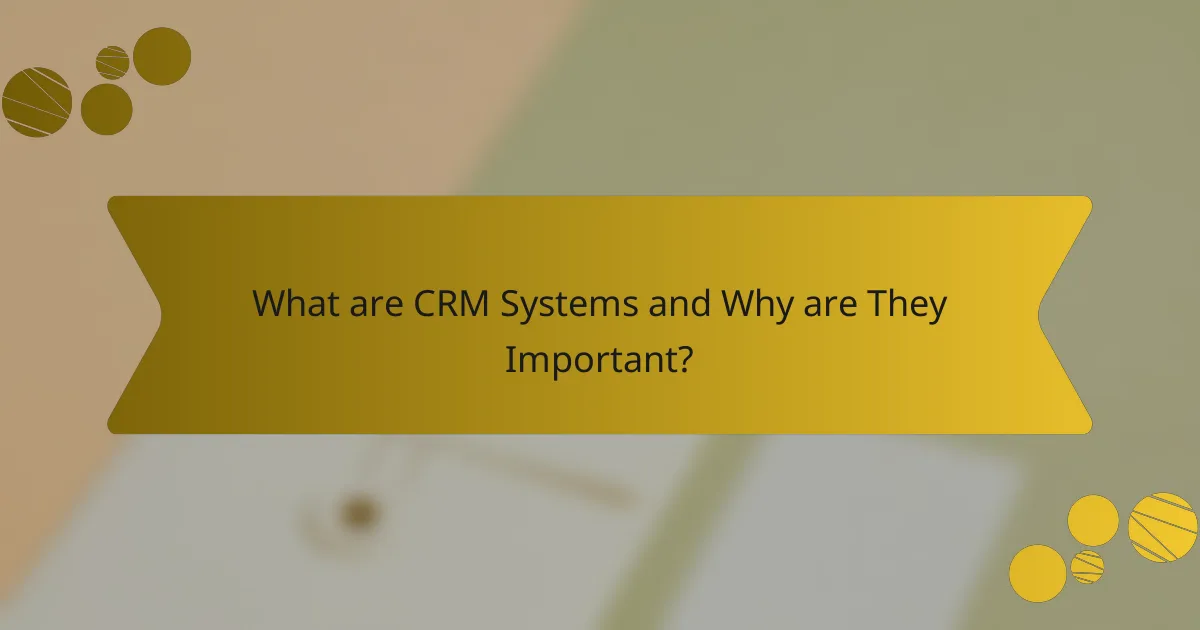CRM systems are software solutions that facilitate the management of a company’s interactions with current and potential customers. This article explores the essential metrics tracked within CRM systems, such as customer acquisition cost, customer lifetime value, and sales conversion rate, highlighting their significance in evaluating marketing effectiveness and long-term profitability. It also discusses effective reporting techniques, particularly the use of dashboards for visual data representation, and emphasizes the critical role of user experience in enhancing CRM adoption and overall effectiveness. Understanding these components is vital for organizations aiming to improve customer relationships, optimize sales processes, and drive revenue growth.

What are CRM Systems and Why are They Important?
CRM systems are software solutions designed to manage a company’s interactions with current and potential customers. These systems centralize customer information, streamline communication, and enhance sales processes. CRM systems improve customer relationships by providing insights into customer behavior and preferences. They enable businesses to track sales leads, manage customer service, and analyze data for better decision-making. According to a study by Nucleus Research, companies that use CRM systems see an average return on investment of $8.71 for every dollar spent. This demonstrates their importance in driving sales and improving customer satisfaction.
How do CRM Systems function in a business environment?
CRM systems function by centralizing customer data and facilitating communication within a business. They collect and store information about customers, including contact details, purchase history, and preferences. This data enables businesses to analyze customer behavior and tailor their marketing strategies accordingly. CRM systems also automate sales processes, track interactions, and manage customer relationships effectively. They improve collaboration among teams by providing shared access to customer information. According to a study by Nucleus Research, CRM systems can increase sales productivity by 14% and improve customer retention rates. This demonstrates their effectiveness in a business environment.
What are the key components of a CRM System?
The key components of a CRM system include contact management, sales management, customer service, and reporting. Contact management stores customer information and interaction history. Sales management tracks sales activities and pipelines. Customer service tools facilitate support and issue resolution. Reporting features analyze data for insights and performance metrics. These components work together to enhance customer relationships and drive business growth.
How do these components interact to support user needs?
CRM systems integrate essential metrics, reporting techniques, and user experience to meet user needs effectively. Essential metrics provide data-driven insights that inform user decisions. Reporting techniques facilitate the visualization of data, making it easier for users to interpret information. User experience design ensures that the interface is intuitive and accessible. Together, these components create a cohesive system that enhances user engagement. For example, streamlined reporting enhances quick decision-making, while user-friendly interfaces reduce the learning curve. This synergy results in improved satisfaction and productivity among users.
What are the primary benefits of using CRM Systems?
CRM systems enhance customer relationship management by centralizing data. They improve customer service through better access to information. CRM systems streamline communication, leading to more efficient interactions. They enable personalized marketing strategies based on customer data. Increased sales productivity is another benefit, as they automate repetitive tasks. Data analysis capabilities help businesses make informed decisions. Enhanced collaboration among teams is facilitated by shared access to customer information. According to a study by Nucleus Research, CRM systems can increase sales by 29%.
How do CRM Systems enhance customer relationships?
CRM systems enhance customer relationships by centralizing customer data and interactions. They provide businesses with a comprehensive view of customer preferences and behaviors. This data helps in personalizing communication and marketing strategies. CRM systems also facilitate timely follow-ups and support, improving customer satisfaction. According to a study by Nucleus Research, CRM systems can increase sales productivity by 14%. This productivity boost results from better organization and access to customer information. Furthermore, CRM systems enable tracking of customer interactions, which helps in identifying trends and addressing issues proactively. Overall, these systems create a more engaging and responsive customer experience.
What impact do CRM Systems have on sales and marketing?
CRM systems significantly enhance sales and marketing effectiveness. They streamline customer data management, enabling personalized communication. This personalization leads to improved customer engagement and satisfaction. According to a study by Nucleus Research, CRM applications can boost sales productivity by 34%. Furthermore, CRM systems provide valuable insights through analytics, helping teams make informed decisions. They also facilitate better collaboration among sales and marketing departments. This collaboration ensures aligned strategies and messaging. Ultimately, CRM systems drive revenue growth by optimizing the sales funnel and improving lead conversion rates.

What Essential Metrics Should be Tracked in CRM Systems?
Essential metrics tracked in CRM systems include customer acquisition cost, customer lifetime value, and sales conversion rate. Customer acquisition cost measures the total expense to acquire a new customer. This metric helps businesses evaluate the effectiveness of their marketing strategies. Customer lifetime value estimates the total revenue a customer generates during their relationship with a company. It assists in understanding long-term profitability. Sales conversion rate tracks the percentage of leads that convert into paying customers. This metric highlights the effectiveness of the sales process. Additionally, tracking customer retention rate is crucial. It indicates the percentage of customers that continue to do business over a specific period. Monitoring these metrics allows organizations to optimize their CRM strategies and improve overall performance.
What are the key performance indicators (KPIs) for CRM success?
Key performance indicators (KPIs) for CRM success include customer retention rate, customer lifetime value, and sales conversion rate. Customer retention rate measures the percentage of customers who continue to use a company’s products or services over a specific period. According to a study by Bain & Company, increasing customer retention by just 5% can increase profits by 25% to 95%.
Customer lifetime value (CLV) calculates the total revenue a business can expect from a single customer account. Understanding CLV helps businesses allocate resources effectively to maximize customer relationships. A report by HubSpot indicates that loyal customers are worth up to 10 times as much as their first purchase.
Sales conversion rate tracks the percentage of leads that turn into actual sales. This KPI is crucial for evaluating the effectiveness of sales strategies. Research from Marketing Metrics shows that the average conversion rate is around 2.35%, but top performers can achieve rates of up to 11%.
Other important KPIs include average deal size, customer acquisition cost, and net promoter score (NPS). Average deal size reflects the average revenue generated per closed deal. Customer acquisition cost measures the total cost of acquiring a new customer. NPS gauges customer loyalty and satisfaction, with scores ranging from -100 to +100.
How can customer acquisition costs be measured?
Customer acquisition costs can be measured by calculating the total expenses incurred to acquire new customers. This includes marketing expenses, sales team salaries, and overhead costs. Divide the total costs by the number of new customers acquired during a specific period. For example, if a company spends $10,000 and acquires 100 customers, the customer acquisition cost is $100. This metric helps businesses assess the effectiveness of their marketing strategies. According to HubSpot, understanding this cost is crucial for optimizing budgets and improving profitability.
What role does customer lifetime value play in CRM metrics?
Customer lifetime value (CLV) is a crucial metric in customer relationship management (CRM). It quantifies the total revenue a business can expect from a customer over their entire relationship. CLV helps businesses identify their most valuable customers. This allows for targeted marketing and personalized services. By focusing on high-CLV customers, companies can improve retention strategies. Research indicates that increasing customer retention by 5% can boost profits by 25% to 95%. Thus, integrating CLV into CRM metrics enhances overall profitability and customer satisfaction.
How can businesses effectively analyze CRM data?
Businesses can effectively analyze CRM data by utilizing data segmentation, visualization tools, and predictive analytics. Data segmentation allows businesses to categorize customers based on attributes like demographics and purchase history. This targeted approach enhances insights into customer behavior. Visualization tools, such as dashboards, help present data clearly and identify trends quickly. Predictive analytics uses historical data to forecast future customer actions. This method supports strategic decision-making. According to a study by Salesforce, companies that utilize data-driven decision-making are 23 times more likely to acquire customers.
What tools can be used for CRM reporting and analysis?
CRM reporting and analysis can be conducted using various tools. Popular CRM tools include Salesforce, HubSpot, and Zoho CRM. Salesforce offers customizable reports and dashboards for detailed analysis. HubSpot provides user-friendly reporting features with marketing and sales integration. Zoho CRM includes advanced analytics and AI-driven insights. Other notable tools are Microsoft Dynamics 365 and Pipedrive, which also support comprehensive reporting. These tools help businesses track performance metrics effectively.
How does data visualization enhance CRM insights?
Data visualization enhances CRM insights by transforming complex data into clear visual formats. This clarity allows users to quickly identify trends and patterns. Visualizations like charts and graphs make data more accessible. They facilitate better decision-making by highlighting critical metrics. For instance, a study by Gartner shows that organizations using data visualization can improve their decision-making speed by 5 times. Enhanced engagement with data leads to increased user adoption of CRM systems. Ultimately, effective data visualization drives actionable insights that improve customer relationships.

What Reporting Techniques are Most Effective for CRM Systems?
Dashboards are the most effective reporting technique for CRM systems. They provide a visual representation of key metrics. Dashboards allow users to monitor performance at a glance. They typically include charts, graphs, and tables. This visual format makes data interpretation easier. Reports can be customized based on user needs. Customization enhances the relevance of the information presented. Additionally, automated reporting saves time and reduces manual errors. Scheduled reports ensure stakeholders receive timely updates. These techniques improve decision-making and strategic planning.
How can businesses create meaningful CRM reports?
Businesses can create meaningful CRM reports by identifying key performance indicators (KPIs) relevant to their goals. KPIs provide measurable values that demonstrate how effectively a company is achieving its objectives. They should align with sales, customer satisfaction, and marketing effectiveness.
Next, businesses need to collect and analyze data from various sources within the CRM system. This data should include customer interactions, sales history, and feedback. Proper data segmentation enhances the relevance of insights generated.
Visualization tools can help present the data in a clear and engaging manner. Graphs, charts, and dashboards allow stakeholders to quickly interpret the information.
Regularly reviewing and updating the reports ensures they remain relevant. This involves adjusting the KPIs as business needs evolve.
Lastly, soliciting feedback from users of the reports can improve their effectiveness. Engaging users helps identify what information is most useful and how it can be better presented.
What types of reports are essential for CRM analysis?
Sales performance reports are essential for CRM analysis. These reports track sales metrics over specific periods. They help identify trends in sales growth or decline. Customer segmentation reports categorize customers based on various criteria. This allows businesses to tailor marketing strategies effectively. Lead conversion reports analyze the efficiency of converting leads into customers. They provide insights into the sales funnel’s effectiveness. Customer satisfaction reports gauge customer feedback and satisfaction levels. These reports are crucial for improving customer service and retention. Finally, activity reports summarize interactions with customers. They help in monitoring team performance and engagement levels.
How can automated reporting improve efficiency?
Automated reporting improves efficiency by streamlining data collection and analysis. It reduces the time spent on manual reporting tasks. Employees can focus on strategic decision-making instead of data entry. Automation minimizes human error, enhancing the accuracy of reports. Real-time data access allows for quicker insights and responses. A study by McKinsey found that automation can increase productivity by up to 30%. This efficiency leads to better resource allocation and improved operational workflows. Overall, automated reporting transforms reporting processes into a more efficient and reliable system.
What are the best practices for interpreting CRM data?
The best practices for interpreting CRM data include ensuring data accuracy, segmenting data effectively, and utilizing visualization tools. Accurate data is crucial for reliable insights. Regularly cleaning and validating data can enhance accuracy. Segmenting data allows for targeted analysis. This helps in understanding customer behavior and preferences. Utilizing visualization tools simplifies complex data sets. Charts and graphs can reveal trends and patterns quickly. Additionally, establishing clear KPIs aids in measuring performance. KPIs should align with business objectives for meaningful analysis. Lastly, involving team members in the interpretation process fosters diverse perspectives. Collaboration can lead to more comprehensive insights.
How can businesses ensure accuracy in their CRM data interpretation?
Businesses can ensure accuracy in their CRM data interpretation by implementing regular data audits. These audits identify inconsistencies and errors in data entries. Training staff on data entry best practices is essential. Proper training reduces human errors significantly. Utilizing automated data validation tools enhances accuracy. These tools can flag incorrect or incomplete information in real-time. Establishing clear data governance policies also helps maintain data integrity. Research indicates that organizations with strong data governance see a 25% improvement in data quality. Regularly updating and cleaning the database ensures that outdated information is removed. This practice keeps the data relevant and reliable for interpretation.
What common pitfalls should be avoided in CRM reporting?
Common pitfalls in CRM reporting include data inaccuracy, lack of standardization, and insufficient training. Data inaccuracy can lead to misguided decisions. This often occurs due to manual data entry errors or outdated information. Lack of standardization results in inconsistent metrics across reports. This inconsistency complicates comparisons and analysis. Insufficient training for users can hinder effective use of CRM tools. Users may not fully understand how to extract or interpret data. Additionally, focusing on irrelevant metrics can distract from key performance indicators. This misalignment can obscure insights that drive business growth. Finally, neglecting to regularly review and update reports can lead to stale data. Stale data diminishes the relevance of insights derived from reporting.

How Does User Experience Influence CRM Effectiveness?
User experience significantly influences CRM effectiveness by shaping user engagement and satisfaction. A positive user experience leads to higher adoption rates of CRM systems. When users find the interface intuitive and easy to navigate, they are more likely to utilize its features fully. Research indicates that 70% of CRM implementations fail due to poor user adoption. Enhancing user experience can reduce training time and support costs. Furthermore, effective user experience design can improve data accuracy and user productivity, leading to better customer insights. A study by Salesforce found that companies with high user satisfaction reported 25% more revenue growth. Thus, prioritizing user experience is essential for maximizing CRM effectiveness.
What factors contribute to a positive user experience in CRM Systems?
Key factors that contribute to a positive user experience in CRM systems include usability, customization, and integration capabilities. Usability ensures that users can navigate the system easily and efficiently. A user-friendly interface enhances interaction and reduces the learning curve. Customization allows organizations to tailor the CRM to their specific needs. This flexibility helps users feel more comfortable and engaged. Integration capabilities enable seamless data flow between the CRM and other tools. This connectivity enhances productivity and reduces data silos. Additionally, strong customer support is crucial for resolving issues quickly. Research indicates that organizations with high user satisfaction in CRM report increased customer retention and sales performance.
How does user interface design impact CRM usability?
User interface design significantly impacts CRM usability by influencing how easily users can navigate and interact with the system. A well-designed interface enhances user satisfaction and efficiency. It allows for intuitive access to features and information, reducing the learning curve for new users. Studies show that 70% of users prefer software with a user-friendly design. This preference leads to increased productivity and lower frustration levels. Poor interface design, conversely, can lead to errors and decreased adoption rates. Research indicates that 50% of CRM implementations fail due to usability issues. Thus, effective user interface design is crucial for maximizing CRM effectiveness and user engagement.
What training and support are necessary for effective CRM use?
Effective CRM use requires comprehensive training and ongoing support. Training should cover system navigation, data entry, and report generation. Users must understand CRM features to maximize efficiency. Regular workshops enhance user skills and adapt to updates. Support includes access to technical assistance and troubleshooting resources. Organizations should provide a knowledge base for self-service solutions. Feedback mechanisms help identify training gaps. Continuous learning fosters user engagement and system optimization.
How can user feedback be utilized to improve CRM Systems?
User feedback can be utilized to improve CRM systems by identifying user pain points and preferences. This feedback allows developers to prioritize features that enhance user experience. Regular surveys and feedback forms can capture insights on usability and functionality. Analyzing this data helps in making informed design decisions. For instance, 70% of users prefer streamlined interfaces, which can guide UI improvements. Additionally, feedback can reveal training needs, enabling better onboarding processes. Implementing changes based on user suggestions fosters customer loyalty and satisfaction. Companies like Salesforce have successfully integrated user feedback to refine their platforms, leading to increased user engagement.
What methods can be employed to gather user feedback?
Surveys are a common method employed to gather user feedback. They can be conducted online, via email, or in person. Surveys allow for quantitative data collection through structured questions. Interviews are another effective method. They provide qualitative insights through open-ended discussions. Focus groups facilitate feedback through group interactions and discussions. Usability testing allows users to interact with a product while providing feedback on their experience. Feedback forms on websites can capture user opinions in real-time. Social media monitoring can also gather user sentiments and feedback. Each of these methods contributes to understanding user needs and improving products.
How can businesses implement changes based on user insights?
Businesses can implement changes based on user insights by analyzing feedback and data. They should collect user insights through surveys, interviews, and usage analytics. This data helps identify pain points and opportunities for improvement. Next, businesses need to prioritize changes based on the insights gathered. They can use frameworks like the Kano Model to categorize features. After prioritization, companies should develop a clear action plan for implementation. This plan must outline specific changes, timelines, and responsible teams. Finally, businesses should monitor the impact of these changes through ongoing user feedback and metrics. This iterative process ensures continuous improvement based on user needs.
What are some practical tips for optimizing CRM user experience?
To optimize CRM user experience, implement user-friendly interfaces and streamline navigation. A clean design enhances usability. Regularly gather user feedback to identify pain points. This approach allows for targeted improvements. Offer comprehensive training sessions for users to maximize system benefits. According to a study by Salesforce, 70% of users feel more confident using a system after proper training. Integrate automation features to reduce repetitive tasks. Automation can increase efficiency and user satisfaction. Customize dashboards to display relevant metrics for each user. Personalized views improve engagement and productivity. Finally, ensure mobile accessibility for users on the go. Mobile-friendly systems lead to higher user adoption rates.
CRM systems are software solutions that manage interactions between businesses and their customers, centralizing data to enhance communication and sales processes. This article explores essential metrics for evaluating CRM effectiveness, including customer acquisition cost and sales conversion rate, as well as effective reporting techniques that utilize dashboards and automation. It also examines the impact of user experience on CRM adoption and performance, highlighting the importance of usability, training, and user feedback in optimizing these systems. Overall, the content provides a comprehensive overview of how CRM systems can drive business growth through improved customer relationships and data-driven decision-making.
